
* In the late 1930s, given the rise of aggressive authoritarian regimes in Europe and Asia, the United States began to rearm, with one of the facets of this effort being the development of new combat aircraft to match those of potential adversaries. The P-38 was one of the most important products of this effort, and though its introduction to service was not entirely smooth, it would prove a significant asset to the American war effort.
* The Lockheed P-38 was designed in response to a 1937 US Army Air Corps (USAAC) specification designated "Project X608" for a fast high-altitude twin-engine interceptor, capable of 580 KPH at an altitude of 6,100 meters (360 MPH at 20,000 feet). Five companies -- Consolidated, Curtiss, Douglas, Lockheed, and Vultee -- submitted proposals.
The Lockheed team was under the direction of Clarence "Kelly" Johnson, who would eventually design a string of famous aircraft up to the SR-71 Blackbird Mach-3 spy plane. Johnson's initial concepts for the new fighter covered a range of configurations -- varying from the straightforward, with an engine on each wing, to the very unorthodox, with the twin engines fitted tandem in the fuselage driving props on the front or back of the wing via some sort of power transmission system. The Lockheed team finally decided on a scheme in the middle of the range, with twin booms to accommodate the engines, and with the pilot and armament in a central nacelle. The aircraft was designated the "Lockheed Model 22". The engines were to be turbocharged 12-cylinder, vee-inline, water-cooled Allison V-1710 engines.
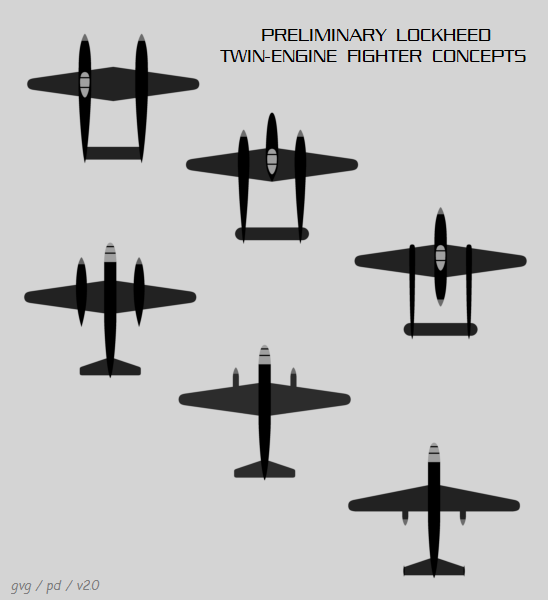
When Johnson selected the Allison, it had not been rated at even 750 kW (1,000 HP) -- but it was really the only large inline engine available in the US at the time. The propellers would rotate in opposite directions to eliminate the effect of torque. The General Electric B-1 turbochargers were positioned in the booms, behind the engines; there were cooling system radiators on each side of the booms behind the turbochargers. There was an intercooler system running through the outer wings to cool off the compressed air before it flowed into the engines. Armament was to consist of four machine guns in the nose of the nacelle, clustered around a cannon.
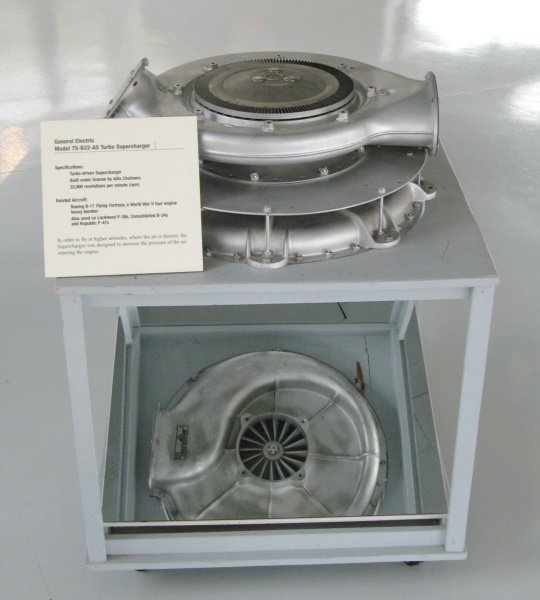
The Lockheed submission won the competition on 23 June 1938, and the company was awarded a contract to build a single "XP-38" prototype. The XP-38 was rolled out in December 1938 and first flew on 27 January 1939, with USAAC Lieutenant Benjamin Kelsey at the controls, who by no coincidence had helped drive Project X608 in the first place. Kelsey found he couldn't retract the flaps and thought of bailing out, but he managed to get back down on the ground safely. The problem was quickly fixed and later flights went much better, demonstrating the impressive performance of the type.
The XP-38 provides a baseline for the Lightning family; it would undergo many changes during its production, but the basic configuration would remain the same. The XP-38 was built primarily of aircraft aluminum alloy. The two-spar wings were mid-mounted, with Fowler flaps -- extending behind the wing when deployed, featuring an inboard and outboard section -- and ailerons. There was an elevator on the tailplane running between the tailfins, and a rudder on each of the "guitar-pick" tailfins. There was a bumper under each tailfin to handle tail strikes. There were trim tabs on the ailerons, elevator, and rudders. All controls were manual, except for hydraulically-driven flaps.
The design featured tricycle landing gear, making the aircraft one of the first with such a feature. All gear had single wheels, all retracting backwards, the main gear retracting into the engine booms. It is unclear if the nosewheel was steerable. The XP-38 was powered by "handed" Allison V-1710-11 and V1710-15 engines with 716 kW (960 HP) each. It had two fuel tanks in each wing inboard of the engine booms, with a total fuel capacity of 1,554 liters (410 US gallons). Each tank had its own refueling port, but fuel could be shunted from one set of tanks to the other. It had a framed bubble canopy; for access, the top panel hinged back, while the windows on each side slid down.
With Kelsey at the controls, the XP-38 set a cross-continental speed record by flying from California to New York on 11 February 1939, in 7 hours and 2 minutes, including two fuel stops. The initial purpose of the flight was simply to transfer the aircraft to Wright Field in Ohio for USAAC evaluation, but extending the flight provided an opportunity to show the world what the latest American fighters could do. General Henry "Hap" Arnold, commander of the USAAC, approved the flight, on the condition that the aircraft be checked out on its "pit stop" at Wright Field to see if it should go the rest of the way. Unfortunately, due to carburetor icing while in the final landing pattern, the prototype landed short of the runway in New York and was wrecked. Kelsey was unharmed.
* Despite the setback, partly on the basis of the record flight the Air Corps ordered 13 "YP-38" evaluation aircraft in April 1939. Unfortunately, manufacture of the YP-38s proved troublesome, and the first didn't roll off the production line until September 1940, with the last delivered in June 1941. Although they looked much like the custom-built XP-38, they were substantially redesigned and differed greatly in detail. They were lighter and featured changes in engine fit, most particularly in that the direction of propeller spin was reversed, with the propellers rotating up towards the cockpit instead of down as had been the case in the XP-38.
The YP-38s were powered by Allison V-1710-27/29 engines with 858 kW (1,150 HP) each and improved GE B-2 turbochargers. Although weapons were not fitted in most of these aircraft, they were designed to be armed with two 12.7-millimeter (0.50-caliber) Browning machine guns with 200 rounds per gun, two 7.62-millimeter (0.30-caliber) Browning machine guns with 500 rounds per gun, and an Oldsmobile 37-millimeter cannon with 15 rounds.
BACK_TO_TOP* The USAAC ordered 66 production aircraft in September 1939, after the beginning of the war in Europe, and would follow that order up with more. The French and the British ordered 150 examples in April 1940, with a "Model 322F" for the French and a "Model 322B" for the British. Each of these variants had unique minor equipment fits tailored for their respective air arms, such as metric measurements on the flight indicators for the French aircraft, but they both shared a major change from all other P-38 variants that were ever made: the turbochargers were to be deleted, and the left-handed and right-handed engine arrangement was to be changed to twin right-handed engines.
Since turbochargers were a new technology, the Anglo-French purchasing commission that ordered the fighters was concerned that the turbochargers might lead to delays, and felt that since the aircraft were intended for medium-altitude combat, the turbochargers would not be needed. The requirement for the sole use of right-handed engines was for commonality with the large numbers of Curtiss Tomahawks both nations had on order. Lockheed engineers protested strongly against this decision, and privately labeled the variant the "castrated" P-38.
After the fall of France in June 1940, the British took over the entire order. Three of the castrated Lightning Is were delivered to the UK in March 1942, to be promptly and unsurprisingly given a thumbs-down. They "redlined" at 480 KPH (300 MPH) and had nasty handling characteristics. The entire order for Lightning Is was canceled, as was a follow-on order for 524 "Lightning IIs" that would have had turbochargers, but not handed engines.
147 (some sources say 140) Lightning Is on the British order were completed for the US Army Air Forces (USAAF, which superseded the USAAC in June 1941). They were fitted with handed engines but still lacked turbochargers, and were given the designation of "RP-322". These aircraft helped the USAAF train new pilots to fly a powerful and complex new fighter. The RP-322 was actually a fairly hot aircraft at low altitude and satisfactory in the training role. The other positive result of the RAF fiasco was to give the aircraft its name: "Lightning".
* 30 initial production "P-38 Lightnings" were delivered to the USAAF in mid-1941. Although not all these aircraft were armed, some were fitted with four 12.7-millimeter Browning machine guns, instead of the pair of 12.7-millimeter and pair of 7.62-millimeter weapons of their predecessors. The 37-millimeter cannon was retained. They also had an armor glass plate behind the windscreen, cockpit armor, and fluorescent instrument lighting. One was completed with a pressurized cabin on an experimental basis and designated "XP-38A".
The 30 P-38s were part of the initial USAAF order for 66, but in light of feedback from the war overseas, the remaining 36 in the batch were fitted with various small improvements such as self-sealing tanks and enhanced armor protection to make them "combat capable". The self-sealing tanks reduced fuel capacity to 1,137 liters (300 US gallons). These these 36 aircraft were designated "P-38D", the "P-38B" and "P-38C" being unbuilt variants.
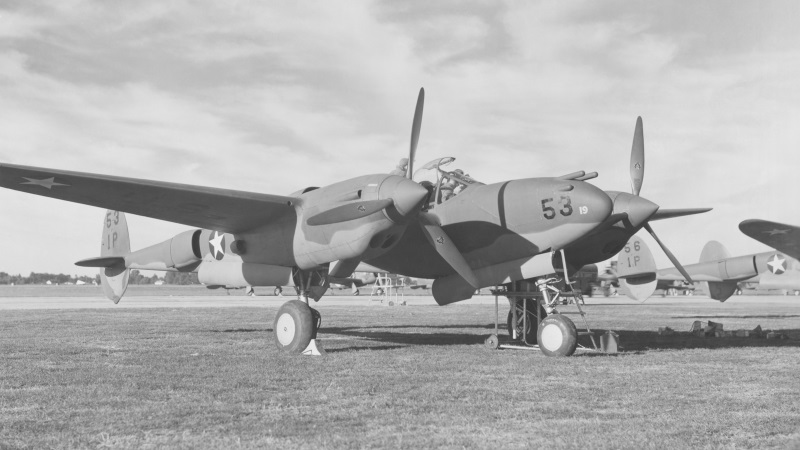
* None of these aircraft ever saw combat. Their main role in the story of the P-38 was to work out bugs and give the USAAF experience with handling the type.
Tail flutter was quickly found to be a problem. As a fix, small weights were attached to little booms in the middle of the elevator. Kelly Johnson was contemptuous of the "fix", regarding the weights as useless, and in fact the buffeting eventually proved to be due to the straight connection of the wing root to the fuselage pod. A few aerodynamic changes, most particularly the addition of a wing-root fillet, solved the problem, but the little weights were a feature of every P-38 built from then on.
A more serious problem was "compressibility stall", the tendency of the controls to simply lock up in a high-speed dive, leaving the pilot no option but to bail out. The tail structure also had a nasty tendency to fall apart under such circumstances, and in fact this problem killed a YP-38 test pilot, Ralph Virden, in November 1940. A USAAC major named Signa Gilkey managed to stay with a YP-38 in a compressibility lockup, riding it out until he got to denser air, where he recovered using elevator trim. This feat led to experiments that would eventually resolve the trouble.
Kelly Johnson later recalled: "I broke an ulcer over compressibility on the P-38 because we flew into a speed range where no one had ever been before, and we had difficulty convincing people that it wasn't the funny-looking airplane itself, but a fundamental physical problem. We found out what happened when the Lightning shed its tail, and we worked during the whole war to get 15 more knots more speed out of the P-38. We saw compressibility as a brick wall for a long time. Then we learned how to get through it."
That would not be until later, however, and the new P-38 had other defects. The most dangerous hazard was that if one engine failed on take-off, "asymmetric power" would flip the aircraft over, and slam it upside-down into the ground. Eventually, procedures were devised to allow a pilot to deal with the situation: reduce power on the running engine, feather the prop on the dead engine, and then increase power gradually until the aircraft was in stable flight. That took a skilled pilot. An unskilled pilot was dead. The P-38 went into combat with a bad reputation.
BACK_TO_TOP* The first Lightning to go to war was the "P-38E", which featured:
Interestingly, while the machine guns had been arranged symmetrically in the nose on earlier variants, they were "staggered" in the P-38E and later versions, with the muzzles sticking out of the nose in the relative lengths of roughly 1:4:6:2. This was done to ensure a straight ammunition belt feed into the weapons, since the earlier arrangement had led to jams.
The first P-38E rolled out of the factory in October 1941. 210 P-38Es were built. They were followed, starting in April 1942, by the "P-38F", which featured Allison V-1710-49/53 engines with 988 kW (1,325 HP each); an SCR-522 or SCR-535 radio; and racks inboard of the engines for fuel tanks -- initially only 284 liters (75 US gallons) each -- or a total of 900 kilograms (2,000 pounds) of bombs. 527 P-38Fs were built. Some P-38Fs were modified to familiarization trainers by yanking the radio and putting a second seat in back; the back-seater had to scrunch forward to fit, and spending any major amount of time in that position would have almost certainly led to back injuries, but it was a useful expedient for showing new pilots the ropes before they tried to take up a P-38 on their own.
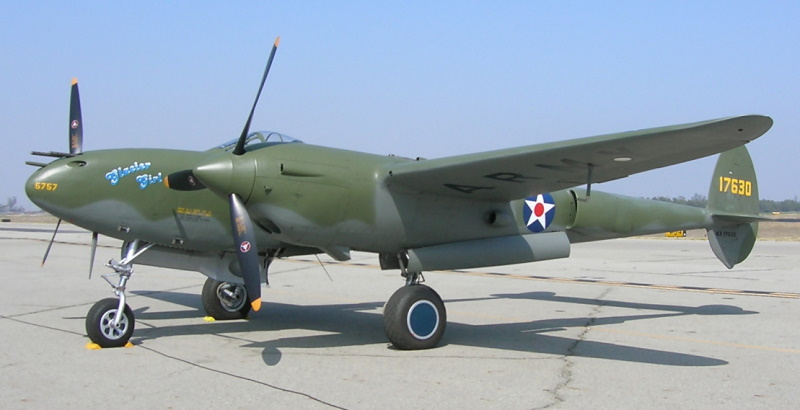
99 photo-reconnaissance machines based on the P-38E and designated "F-4" were built as well, with the guns replaced by four K-17 cameras in a modified nose. The F-4 was the first Lightning to see combat, beginning operations out of Australia and then New Guinea in April 1942. Three of the F-4s were operated by the Royal Australian Air Force in this theater for a short period, beginning in September 1942. 20 "F-4As" based on the P-38F were also built.
By June 1942, P-38s were operating in the Aleutians as well. The fighter's long range made it well suited to the campaign over the almost 2,000-kilometer (1,200-mile) island chain, and it would be flown there for the rest of the war. It was one of the most rugged environments available for testing the new aircraft under combat conditions. More Lightnings were lost there due to weather and other conditions than enemy action. There were cases where Lightning pilots, mesmerized by flying for hours over gray seas under gray skies, simply flew into the water.
The P-38 still scored successes. On 4 August 1942, two P-38Es, operating at the 1,600-kilometer (1,000-mile) end of a long-range patrol, bounced a pair of Japanese Kawanishi H6K "Mavis" flying boats and destroyed them. They were the first of many Japanese aircraft to be shot down by the Lightning.
In the meantime, Lightnings were ferrying themselves across the Atlantic via Iceland to England, though most of them made the trip on freighters. On 15 August, a P-38F and a P-40 operating out of Iceland shot down a Focke-Wulf Fw 200 shipping raider over the Atlantic. This was reputedly the first Luftwaffe aircraft destroyed by the USAAF.
The Lightnings sent to England were part of the force being built up for the invasion of North Africa. The invasion took place in November 1942, and Lightning pilots, including those of a photo-reconnaissance unit under the command of Colonel Elliot Roosevelt, the American president's son, then began acquiring familiarity with operating under "austere conditions" and matching their skills and aircraft against the enemy.
The Lightning proved surprisingly maneuverable at low altitudes. The contra-rotating props had the benefit of eliminating the effects of engine torque; and if a Lightning pilot took advantage of the greater power of the P-38 and kept up high speed, he could even out-turn smaller fighters. However, maneuverability wasn't its strong suit, its major virtue in close combat being a "terrific zoom climb" that would leave pursuers in the dust. Luftwaffe pilots also quickly learned not to make head-on attacks on the P-38, since its concentrated firepower made such a tactic suicidal. Although not the best dogfighter, the P-38 was a formidable interceptor and attack aircraft, and in the hands of a good pilot it could be dangerous in air-to-air combat. The P-38 remained a force to be reckoned with in the Mediterranean for the rest of the war.
The Lightning proved ideally suited for the Pacific theater, since it combined excellent performance with very long range required for operations over wide reaches of ocean. While the P-38 was not as agile as the Zero and most other Japanese fighters, its speed and climb gave American pilots the option of choosing to fight or run, and its focused firepower was even more deadly to lightly-armored Japanese warplanes than to the Germans. Horikoshi Jiro, who headed the design team that build the Zero, wrote: "The peculiar sound of the P-38's twin engines became both familiar and hated by the Japanese all across the South Pacific."
General George Kenney, commander of the USAAF Fifth Air Force operating in New Guinea, could not get enough P-38s. This could be seen as limited praise since Kenney otherwise had to rely on serviceable but inadequate P-39s and P-40s; however, Lightning pilots began to compete in racking up scores against Japanese aircraft, including one of the most famous missions of the war, the airborne assassination of Admiral Yamamoto Isoroku on 17 April 1943.
Yamamoto was the architect of Japan's naval strategy in the Pacific. American codebreakers found out that he was flying to Bougainville Island to conduct a front-line inspection. It was not normal US military policy to deliberately assassinate enemy leaders, since it invited retaliation in kind and there was usually no saying that the replacement might not be more effective, but Japan had few military leaders of Yamamoto's stature. 16 Lightnings were sent on a long-range flight to intercept him. The mission went off perfectly, the Lightnings met Yamamoto's Mitsubishi G4M bomber and escorting Zero fighters just as they arrived, and the G4M was shot down over the jungle. The admiral was killed, leading to a long-standing quarrel among the pilots as to who was due the "honors".
* The P-38F was followed in early 1943 by the "P-38G", with Allison V-1710-51/55 engines that offered no increase in power but some technical improvements, but went back to the older SCR-274N radio. 1,082 P-38Gs were built. They could carry triple-tube "bazooka"-type launchers for the M-8 rocket on the bomb pylons, but the M-8 was not a very accurate weapon. Some sources claim that late model P-38Gs could carry triple M-8 rocket tubes on each side of the nose, but if so this fit does not seem to have been used much in practice.
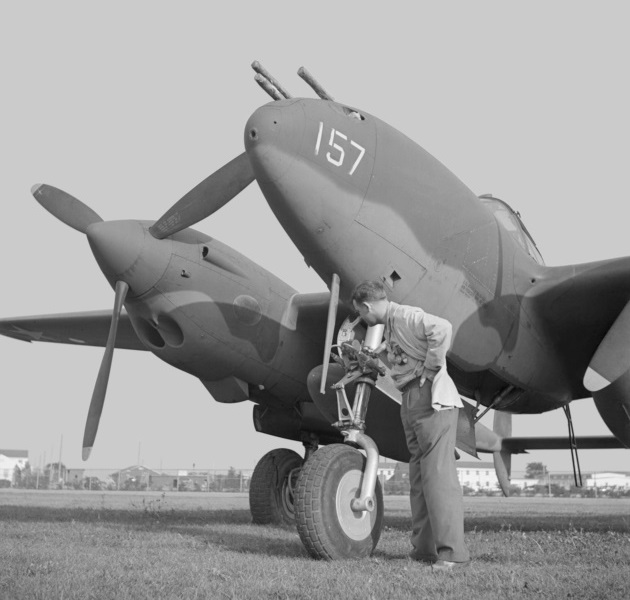
The P-38G was followed in turn by 601 similar "P-38Hs", with further uprated Allison V-1710-89/91 engines with 1,065 kW (1,425 HP) each, an improved 20-millimeter cannon, and a bomb capacity of 1,450 kilograms (3,200 pounds). There was never a "P-38I"; the USAAF didn't use the "I" designation, since it looked like a "1".
180 "F-5A" reconnaissance machines based on the P-38G were built, featuring an improved camera fit; 123 similar "F-5C" machines based on the P-38H were built as well. There was also a single "XF-5D" conversion of an F-5A, which featured a transparent nose for a camera operator lying prone, with a camera flanking him on each side and two guns above.
BACK_TO_TOP* The definitive "P-38J" was introduced in August 1943. The twin booms of previous Lightnings featured a sleek, art-deco streamlining. However, the intercooler system that had been housed in the inner part of the wings had proven vulnerable to combat damage and was inefficient anyway, and so the engine fit was rethought. The most noticeable feature of the new fit was that the radiators were placed under the prop hub at the front of the booms, forming a "beard" that made the P-38J visibly different from its predecessors.
The space left open in each wing was replaced with a leading-edge fuel tank, restoring internal fuel capacity to 1,554 liters (410 US gallons). The revised engine fit made cooling much more efficient and improved both performance and reliability; the V-1710-89/91 engines of the P-38H were retained. The P-38J also had a rear-view mirror at the front of the canopy top panel. It is unclear if the mirror was introduced with the P-38J; pictures of earlier variants sometimes do show the mirror, but not consistently, and it was an item that could be easily refitted to older machines. Some 2,970 P-38Js were built.
The "P-38J-10" production block featured a new armor-glass flat windscreen, replacing the curved glass windscreen backed up by an armor glass plate. The "P-38J-25" production block finally overcame the compressibility problem through the introduction of minor aerodynamic changes. The most significant of these changes was the addition in later production of a set of small dive flaps just outboard of the engines, on the bottom centerline of the wings, to help the aircraft pitch back up in a dive. With these improvements, a USAAF pilot dived one to a terminal velocity of almost 970 KPH (600 MPH) and recovered in one piece.
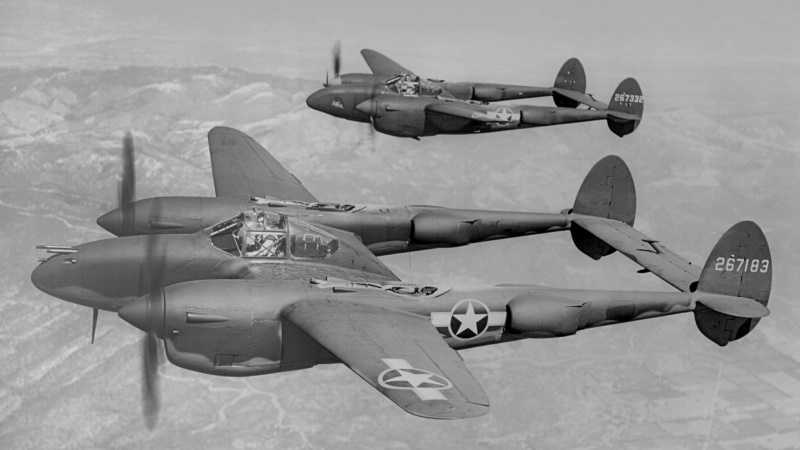
The P-38J-25 also featured power-boosted ailerons, making the P-38J one of the first service aircraft to have such a feature. This improvement did much to improve the Lightning's roll rate and maneuverability. With a truly satisfactory Lightning in place, Lockheed ramped up production, working with subcontractors across the country to produce hundreds of Lightnings each month.
___________________________________________________________________
LOCKHEED P-38J LIGHTNING:
___________________________________________________________________
wingspan:
15.85 meters (52 feet)
wing area:
30.42 sq_meters (327.5 sq_feet)
length:
11.53 meters (37 feet 10 inches)
height:
2.99 meters (9 feet 10 inches)
empty weight:
5,797 kilograms (12,780 pounds)
max loaded weight:
9,798 kilograms (21,600 pounds)
maximum speed:
676 KPH (420 MPH / 365 KT)
service ceiling:
13,410 meters (44,000 feet)
range, no drop tanks:
1,891 kilometers (1,175 MI / 1,022 NMI)
range, with drop tanks:
3,627 kilometers (2,260 MI / 1,965 NMI)
___________________________________________________________________
The 5,000th Lightning built, a P-38J, was painted fire-engine red, and had the name "YIPPEE" painted on the underside of the wings in big letters. This aircraft was used by Lockheed test pilots Milo Burcham and Tony LeVier in remarkable flight demonstrations, performing such stunts as slow rolls at treetop level with one prop feathered to show that the P-38 was not the unmanageable beast of legend. Their exploits did much to reassure pilots that the Lightning might be a handful, but it was no "widow maker".
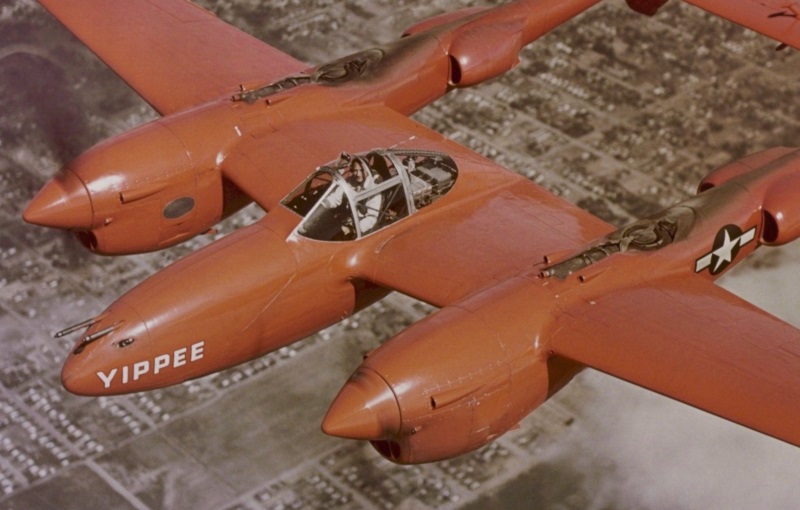
There was a single "P-38K", an experimental version with improved Allisons and wide-chord propellers, but its performance was little better than that of the P-38J, and so the next production version was the "P-38L", which was generally similar to the P-38J but featured still more powerful Allison V-1710-111/113 engines with 1,100 kW (1,475 HP) each.
The P-38L was the most heavily produced variant of the Lightning, with 3,923 built. 113 of the total were built by Consolidated-Vultee in their Nashville plant; the contract was for 3,000, but was cut short at the end of the war. Lockheed production of the Lightning was distinguished by a suffix consisting of a production block number followed by "LO", for example "P-38L-1-LO", while Consolidated-Vultee production was distinguished by a block number followed by "VN", for example "P-38L-5-VN".

The P-38L was fitted to carry the 12.7-centimeter (5-inch) "high velocity air rocket (HVAR)". Initial trials featured seven HVARs on pylons beneath each wing, but this meant too many manufacturing changes, and so the production solution was ten HVARs on each wing on "Christmas tree" launch racks. The P-38L also had strengthened stores pylons to allow carriage of two 900-kilogram (2,000-pound) bombs or 1,140-liter (300 US gallon) drop tanks.
200 "F-5B" reconnaissance aircraft based on the P-38J were built, while 605 "F-5E" reconnaissance machines based on the P-38J and P-38L were built as well. Some P-38Ls were modified with a different camera installation to the "F-5F" standard; a few more P-38Ls were converted to the "F-5G" standard, which featured a distinctive big bulbous nose. Small numbers of P-38Ls were field-modified to become two-seat "TP-38L" familiarization trainers, with no radio and the cramped seat in back.
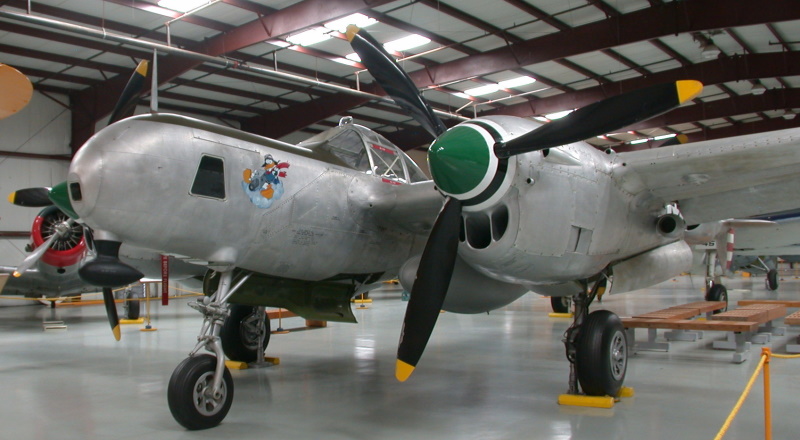
Late model Lightnings were delivered unpainted, as per USAAF policy established in 1944. At first field units tried to paint them, since pilots worried about being too visible to the enemy, but it turned out the reduction in weight was a slight plus in combat.
15 P-38Js and P-38Ls were flown by the Nationalist Chinese late in the war, and after the war they also received a similar number of F-5Es and F-5Gs.
* The new Lightnings were operated by the US Army Eighth Air Force in Europe beginning in 1943 for long-range escort missions, but did not achieve great success in this role. This was partly because it was harder to fly than a single-engine aircraft and, since it had no engine in front of the pilot to keep him warm, was an "icebox" during high-altitude missions. It did have one clear advantage: there were relatively few "friendly fire" losses, since the Lightning's configuration was so distinctive that it was hard to confuse it with anything else. Some Eighth Air Force pilots would do well enough in the P-38, however: Captain Robin Olds, at the beginning of a stellar career, became an ace in the Lightning.
The Eighth operated F-5 recon variants with more enthusiasm and success, though they were better at low-altitude tactical reconnaissance than high-altitude work. They were also operated by a Free French squadron, which worked as part of the USAAF Twelfth Air Force, and in fact the French would continue to operate the type up to 1952. Unfortunately, since F-5s operated alone, when their missions went wrong they generally disappeared without a trace. The noted aviation pioneer and writer Antoine de Saint-Exupery vanished in an F-5 while on a reconnaissance mission over Lyons, France, on 31 July 1944. A French scuba diver found the wreckage of a Lightning in the Mediterranean off Marseille in 2000. The engine serial number matched that of Saint-Exupery's aircraft, and the remains of the aircraft were raised in 2004.
Despite its mixed career in Europe, the Lightning remained an outstanding success in the Pacific. Freezing cockpits were not a problem in the warm tropics. In fact, there was no way to open a window while in flight, since it caused buffeting by setting up turbulence through the tailplane, and it was often too hot; pilots would fly stripped down to shorts, tennis shoes, and parachute.
P-38 pilots racked up big scores against the Japanese. Richard Ira Bong and Tom McGuire of the USAAF competed for the top position, a rivalry made interesting by the contrast in personalities of the two men. Both Bong and McGuire were unbelievably aggressive and fearless in the air. After dogfights, their P-38s -- Bong's was "Marge" after his girlfriend, McGuire's was simply "Pudgie" -- would be warped out of shape by overstress. On the ground, they were completely different men. Dick Bong was a modest, quiet, almost shy man, while the egotistical McGuire was "an unpleasant individual with a talent much bigger than he was," as one of his colleagues remembered him.
The famed Charles A. Lindbergh, working in the South Pacific for Lockheed as an operational test pilot, where he shot down a few Japanese aircraft with his P-38 while "testing his guns", shared a tent with McGuire. Visitors recalled McGuire ordering Lindbergh around, telling him to run errands as though he were a servant.
Bong was rotated back to the States as America's ace of aces, after making 40 kills. He was killed on 6 August 1945, the day the atomic bomb was dropped on Japan, when his P-80 Shooting Star jet fighter flamed out on take-off. McGuire had been killed in air combat in January 1945, over the Philippines, after racking up 38 confirmed kills, making him the second-ranking American ace. Both men were awarded the Medal of Honor. The seventh-ranking American ace, Charles MacDonald, also flew a Lightning against the Japanese, scoring 27 kills in his famous aircraft, the "Putt Putt Maru".
The P-38 fought all around the Pacific, from the Aleutians to New Guinea to Burma and China. A P-38 is said to have been the first American aircraft to land in Japan after VJ-Day, when a pair of them set down on Nitagahara, with the pilots later claiming they were "low on fuel".
BACK_TO_TOP